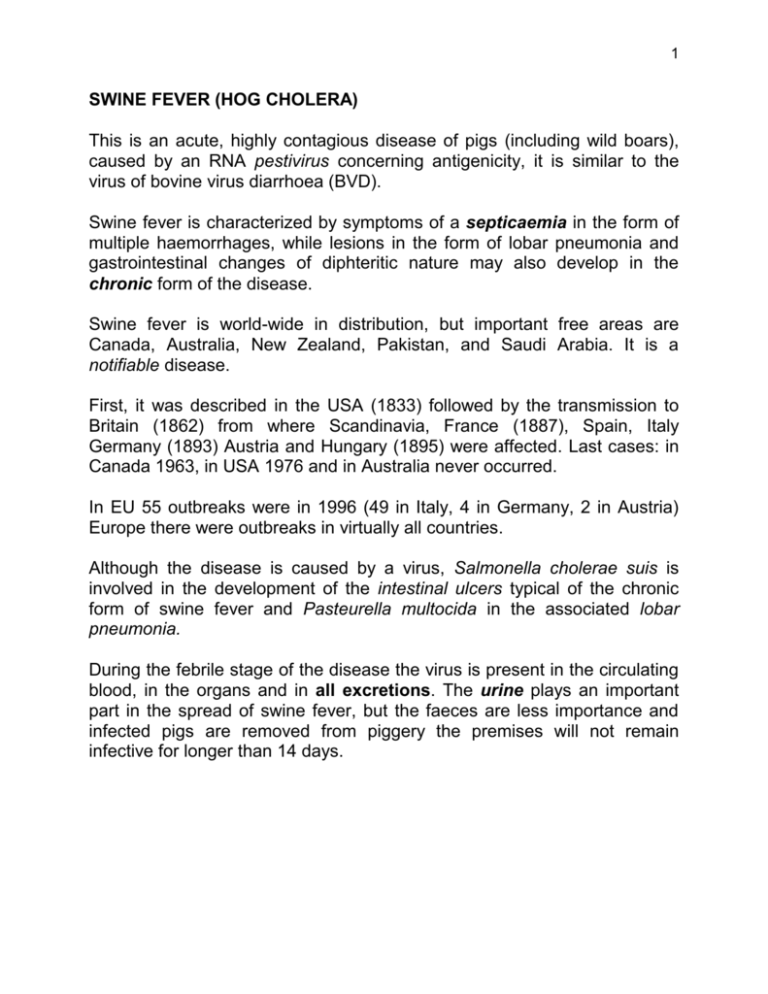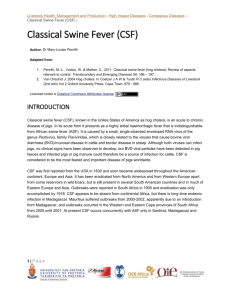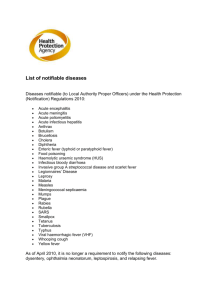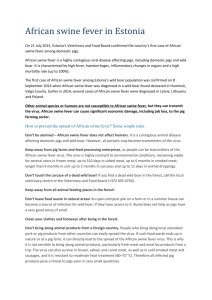Swine fever
advertisement

1 SWINE FEVER (HOG CHOLERA) This is an acute, highly contagious disease of pigs (including wild boars), caused by an RNA pestivirus concerning antigenicity, it is similar to the virus of bovine virus diarrhoea (BVD). Swine fever is characterized by symptoms of a septicaemia in the form of multiple haemorrhages, while lesions in the form of lobar pneumonia and gastrointestinal changes of diphteritic nature may also develop in the chronic form of the disease. Swine fever is world-wide in distribution, but important free areas are Canada, Australia, New Zealand, Pakistan, and Saudi Arabia. It is a notifiable disease. First, it was described in the USA (1833) followed by the transmission to Britain (1862) from where Scandinavia, France (1887), Spain, Italy Germany (1893) Austria and Hungary (1895) were affected. Last cases: in Canada 1963, in USA 1976 and in Australia never occurred. In EU 55 outbreaks were in 1996 (49 in Italy, 4 in Germany, 2 in Austria) Europe there were outbreaks in virtually all countries. Although the disease is caused by a virus, Salmonella cholerae suis is involved in the development of the intestinal ulcers typical of the chronic form of swine fever and Pasteurella multocida in the associated lobar pneumonia. During the febrile stage of the disease the virus is present in the circulating blood, in the organs and in all excretions. The urine plays an important part in the spread of swine fever, but the faeces are less importance and infected pigs are removed from piggery the premises will not remain infective for longer than 14 days. 2 Resistance of the virus to environment The swine fever virus is destroyed in the carcase within 1 or 2 days by the post-mortem muscular acidity. The bone marrow may remain infective for at least 73 days, the meat, blood for 30 days of carcases of animals slaughtered in the incubative stage and immediately chilled. The virus may survive about 5 years in frozen pork. Salting and pickling have a preservative action on the virus for up to 6 months. In faeces and urine the virus is destroyed during 7 days and in putrid carcase 1-2 days. Acidic (pH 3) and especially alkaline pH destroys the virus. Boiling at 60-70 °C for 30 minutes or at 80 °C for 5 minutes kill the virus. Frozen or chilled fresh meat and raw meat products are distinguished objects of potential transmission, altogether with swill. Pigs of all breeds and all ages including wild boars are susceptible, though in younger animals the infection is likely to run a more acute and severe course. Humans and other animals are immune to swine fever. The period of incubation is usually 5-9 days, but may extend to 28 days. Infection is by way of the digestive tract through infected urine or other excretions and in bedding. The virus is highly infective and the disease is spread through the movement of infected or carrier pigs and the consumption of uncooked pork scraps in swill. Human beings, bird and flies may act as intermediate carriers. Pathogenesis Incubation period is 5-10 days and it is multiplied in tonsils. After ingestion, the virus is multiplicating mainly in the tonsils and penetrates the mucous membrane of the digestive tract, enters the blood stream (within 24 hours) and gives rise to symptoms and lesions of a septicaemia. A characteristic feature of swine fever is the production of an endarteritis and proliferation of endothelial cells of the smaller blood vessels that is responsible for the haemorrhages, thrombosis and infarction so very typical of the disease. 3 Symptoms The disease may be peracute, acute or chronic. In peracute cases, usually observable at the beginning of an outbreak, death takes place within some 3 days. In acute cases there is evidence of fever with rise in temperature to 40.542.2 C, accompanied by great thirst and conjuctivitis manifested by a mucopurulent secretion from the eyes and inappetance, diarrhea and dyspnoe. The faeces at first may be firm, but become fluid and yellowish. Symptoms of enteritis in pigs, especially when accompanied by pneumonia, should always arouse suspicion of swine fever. Evidence of haemorrhages on the skin (redness of skin), particularly of the ears, shoulder, belly and root of the tail. These haemorrhages appear as a red rash, later becoming violet that is accentuated by scalding and scraping. There may be loss of control of hind limbs, producing a staggering gait, circling, incoordination, tremor, convulsions. The chronic form of swine fever develops from the acute, and only symptoms evident may be a short cough, periodic attacks of diarrhoea and the inability to thrive. Round, dark, necrotic ulcers may be seen around the coronets and up to the knees and hocks, and should always be regarded as suspicious of swine fever. Necrotic skin lesions, however, may be present without coexisting intestinal lesions. Lesions The virus multiplies in all cells of the body, but causes most damage in the endothelium of blood vessels. In peracute cases the only lesions observed may be those of a septicaemia, i.e., small haemorrhages of both serous and mucous membranes and kidneys, together with moderate swelling and congestion of the lymphatic nodes. In some peracute cases the intestinal mucous membrane may be intensely congested and of a port-wine colour. 4 In acute cases haemorrhages may be found on the skin, in the lung tissue, in the mucous membrane of the larynx, particularly the epiglottis, while they also occur in the trachea, digestive tract, pericardium, endocardium, bladder mucosa and kidneys (turkey egg kidney). Petechiae on the surface of the kidney are common in other febrile conditions of the pig, but these haemorrhages disappear when the kidney is immersed in warm water. The lymph nodes, particularly the bronchial and mesenteric, are swollen and oedematous and show a typical mottled red coloration (marbling) first at the periphery of the node but extending gradually to the centre and caused by the accumulation of red blood cells from haemorrhagic areas. Haemorrhages or haemorrhagic infarcts may also be seen in the spleen, particularly at the edges. In the chronic form the alimentary tract may show lesions as far as the pharynx, on which petechiae or yellow diphteritic deposits may be seen. The stomach is deeply congested and may show haemorrhages or yellow fibrinous deposits, while the faecal contents of the caecum may be almost black. The characteristic lesions may be seen around the ileo-caecal valve. The lesions on the mucous membrane originate over submucosal haemorrhages. They are projecting button-like ulcerations, dirty-yellow, grey or black in colour (Salmonella choleraesuis). The more well defined ulcers show concentric ringing due to progressive deposits of fibrin. In many cases the haemorrhagic base of the ulcer is visible on the peritoneal surface of the intestine. The lungs may be adherent to the thoracic wall, and show numerous petechial haemorrhages, either localized or involving a whole lobe (Pasteurellas, Actionbacillus pleuropneumoniae). In chronic cases of swine fever, however, the principal lesions are confined to the alimentary tract. Diagnosis Laboratory examination histopathology. Differential diagnosis African swine fever by immune-fluorescence, ELISA, PCR, 5 Salmonellosis Swine erysipelas Actinobacillic pleuropneumonia Leptospirosis Aujesky disease Toxicosis accompanied with haemorrhages (no fever) 6 Judgement Classic swine fever belongs to the former List A diseases: Condemned for human consumption. Principles of judgement in certain third countries: In acute septicaemic cases, showing fever, evidence of petechial haemorrhages, lymph node enlargement and enteritis, the carcase should be condemned. The chronic cases associated with extensive bowel ulceration and diarrhoea are often emaciated or too poor and undersized to be passed for food. In swine fever outbreak the apparently healthy in-contact pigs from the infected premises may be consigned by licence of competent authority to an abbatoir for immediate closed-slaughter.








